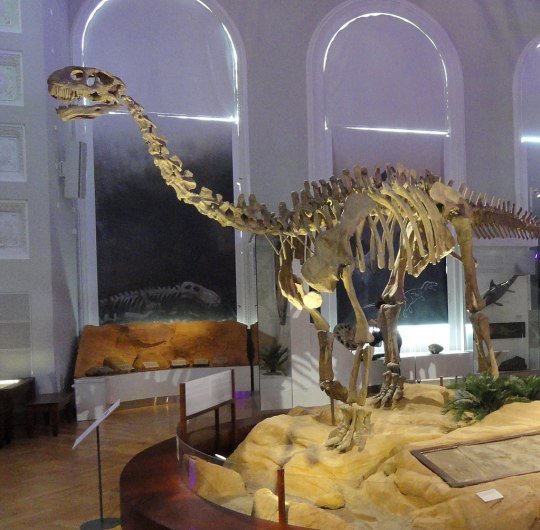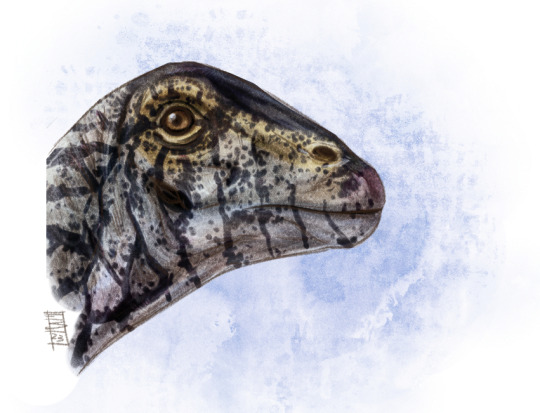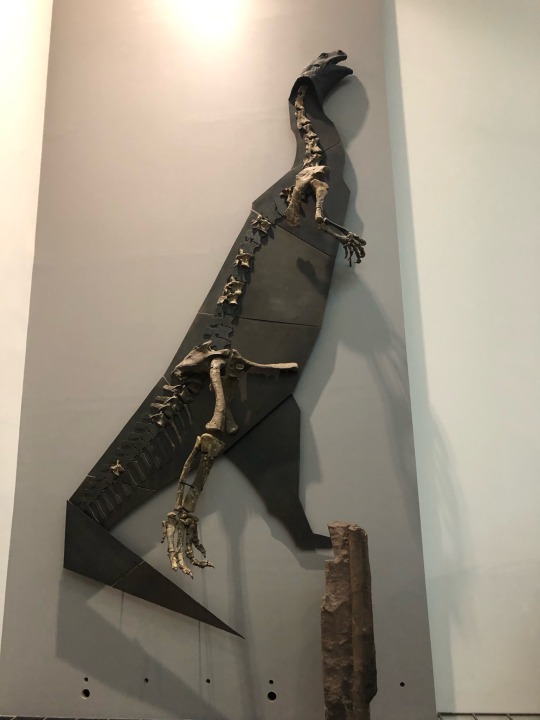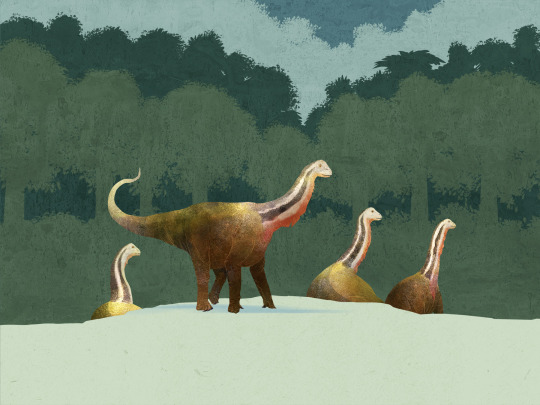#sauropodomorph
Text

A mildly irritated Adeopapposaurus mognai taking a hike in Early Jurassic Argentina 🇦🇷🦕
#dinosaur#illustration#paleoart#paleontology#paleoillustration#paleoblr#palaeoblr#art#palaeontology#sauropodomorph#jurassic period#jurassic world#palaeoart
2K notes
·
View notes
Text

The early sauropodomorph Camelotia traveling on a quest
This was a study on a shot from The Green Knight, saw that movie last week finally and absolutely loved it
So what do I do? Slap a dinosaur in there, as one does
#my art#paleoart#camelotia#sauropodomorph#saurischia#dinosaur#extinct#animal#nature#sciart#triassic#jurassic#britain#mesozoic#prehistoric#the green knight#study#digital art
50 notes
·
View notes
Note
trick or treat

Shunosaurus!
56 notes
·
View notes
Photo

New dinosaur alert! Presenting Mbiresaurus raathi
Image ID: A digital illustration of the early sauropodomorph dinosaur Mbiresaurus. It is a slender, two-legged dinosaur with a long neck and tail and a body covered in fluffy feathers. The feathers are brown with lighter speckles that turn into stripes on the tail. The head and neck are wrinkled and featherless except for a few long feathers that hang from the base of the neck. The head and neck are coloured with patches of black and white, and an orange lower jaw. The Mbiresaurus is posed in a rough three-quarter view, facing to the right and away from the viewer. The neck is upright and alert, the mouth is slightly open, one foot is raised off the ground and the tail is curved around in front of its legs. End ID.
A newly-described species from Zimbabwe, Mbiresaurus is now the oldest named dinosaur species from Africa! It’s an early sauropodomorph, related to dinosaurs like Eoraptor and Buriolestes, and was probably an omnivore.
Mbiresaurus comes from a new fossil site in Zimbabwe, which contains a whole lot of other species that have yet to be described, including a herrerasaurid, which I’ve represented in this size diagram with Staurikosaurus.

Image ID: A size chart showing Mbiresaurus and the early carnivorous dinosaur Staurikosaurus next to a light grey silhouette of a person. The Mbiresaurus’ head is level with the person’s upper thigh, and the Staurikosaurus’ head comes to approximately waist height. End ID.
The formation also includes a number of synapsid species, a rhynchosaur, and an aetosaur, a group of armoured herbivorous crocodile relatives that had never been found in southern Africa before! When combined together into Pangaea, the location of the fossil site matches the latitude of other Late Triassic early dinosaur sites, suggesting that dinosaurs and other Late Triassic species initially migrated across a similar climatic band that would eventually become South America and southern Africa.
#dinosaurs#paleoart#paleontology#new dinosaur#palaeoblr#mbiresaurus#sauropodomorph#triassic#fossils#prehistoric
593 notes
·
View notes
Text
Spectember D27: Revamp the Dinosauroid

The end of the Triassic propitiated finally the dominance of dinosaurs in the next period with the rupture of the large supercontinent Pangea, though in this timeline something pushed further the fragmentation of the continent, and instead of just opening the rift of the Atlantic, it multiplied across Africa and a section of south America, making the Tr/J mass extinction more severe and killing out many more species of dinosaurs, so now the Jurassic was no longer dominated by the animals we have in our timeline, instead we get a strange variety of large dinosaur-like crocodiles, many sauropodomorphs that diverged from the smaller species that survived and never went into the same trend of gigantism as in our earth, many synapsids and so on.
At the end of the late Jurassic a lot happened with the new order, within some of the second radiation of sauropodomorphs included varied carnivorous carnosaur-like species, medium size coelurosaur-like omnivores and smaller herbivores that look like silesaurs; from the omnivore lineage that have expanded in varied niches would rise a branch of semiaquatic species that resembled something like a scaly penguin with hands, long finger and claws, with short robust tails, shorter necks and longer heads with narrow keratinized mouths.
They are remarkable as many other animals of this world, through one particular species seems to have started a peculiar evolutionary trend in the last 10 million years.
For the reader, we will refer to this species as the Shagoids, a species originated from 50 cm long aquatic sauropodomorph descendants that wandered on the estuaries of the now more fragmented north Africa/south American region, their ancestors were more of a mix of a cormorant with an otter as unlike the rest of its own family this belongs, as one main feature of these are they still functional forelimbs, these still preserved functional arms and hands that helped them to manipulate their prey of crustaceans and mollusks. Over time these developed strategies to break down their prey shell, including the habit of picking and using stones which choose appropriately for this task. This behavior was passed on to new generations, learned and properly helped them to get food with less effort, the food quality increased brain energy, brain size also increased and so their skills were forged much more adequately.
It was on matter of few million years the Shagoids lineage abandoned their swimming lifestyle and became mostly semi aquatic coastal dwellers, living in the shores and just entering water to hunt their food rather than spending most of their time there. As social animals they formed hierarchy groups, formed by the head of a dominant female around minor males that could either mate with her or just serve them, as well many other younger individuals, matriarchs often had the duty to select and organize hunting and spending of food, as well regulate reproduction and mating between their lower family, as she normally is the eldest of the group, and only another female of the same blood can turn into a elder matriarch of if mated by the son of the elder, this perhaps was the moment they gained proper sentience as how they defined a cultural and social structure.
It seems at the end rathe in a sudden change of sea level in the last 3 million years did the final push on their evolutionary journey, as most of the Shagoid populations got stranded within the main continent with almost no way to find new connections to large water bodies, in other situation their species would have die for starvation, but at that point they were already adapted to feed on other food sources, from tubers, insects and small animals, being able to cook them using fire they managed to craft, and so properly passed the harsh time with the loss of a chunk of their population over the sudden change.
When the Shagoid expanded and found again large water bodies far from their native regions, they really have changed considerable from their ancestors, as their closest relative was a sort of strange loon like reptilian species wandering in the coasts, these were more like limbed penguins with long arms and tridactyl hands, which the third finger being a derivation of the 4th an 5th clawless digit fused into one, their short legs lost their webbed feet a while ago and are more adapted for walking, their head still preserve the characteristic seabird like shape but their teeth have changed in shape to be generalistic omnivore, with a large head which houses the most intelligent brain in the planet.
Over the last thousands of years, they have been becoming more and more prone to establish permanent settlements populated by hundreds of them much more different of their wandering tribes, often farm plants and even carry some animals for domestication.
For the first time in their history they are in the pathway of civilization… who knows what will happen next, either the Shagoid can remain like this until their extinction, or they will start building towards the sky and beyond.
#speculative evolution#alternative evolution#triassic#jurassic#sauropodomorph#dinosauroid#sapient#spectember
34 notes
·
View notes
Text
Exceptional early Jurassic fossils with leathery eggs shed light on dinosaur reproductive biology
Published 9th October 2023
Description of three adult skeletons and five clutches of embryo-containing eggs of a new sauropodomorph, Qianlong Shouhu , from the Lower Jurassic of southwestern China; the fossils display several significant features that are either unknown or unlike other early-diverging sauropodomorphs.

skeletal reconstruction of Qianlong Shouhu

Egg clutch, eggs and eggshell microstructure of Qianlong Shouhu
Source:
24 notes
·
View notes
Text
Lamplughsaura dharmaramensis, a sauropodomorph from India.

With Hatsune Miku for scale:

24 notes
·
View notes
Text

Sketch_Dippy CM 11255.
Digital, 2023.
25 notes
·
View notes
Text

Plateosaurus. Not sure if they displayed it like this specifically because its name means ‘flat reptile’.
20 notes
·
View notes
Text

Day 8: Mussaurus
A adult version of its kind. In the past, the adult specimens were considered to be unknown for a single specimens of referred to a infant, but now thanks to latest discoveries, they are now fully recognized as new and only species of 2020s.
#dinosaur#paleoart#myart#dinosaurs#dinosauria#my drawings#mussaurus#sauropodomorph#saurischia#sketchbook app#sketchbookapp#dinocember
7 notes
·
View notes
Text
Dinofact #58
Mussaurus, a sauopodomorph, meaning "mouse lizard", was so named because originally, the only known specimens were very small, leading scientists to believe that the dinosaur was an incredibly small sauropodomorph. However, these specimens have since been confirmed to be infant and juvenile, and adult specimens have been discovered. Current estimates show that the dinosaur may have been 6 meters (20 feet) long and weighed more than 1,000 kilograms (2,200 pounds), so the name may be a bit of a misnomer.
#dinosaur#dinosaurs#paleontology#mussaurus#sauropod#sauropods#sauropodomorpha#sauropodomorph#sauropodomorphs#fun facts#trivia#dinosaur trivia#dinosaur fun facts#21st#october#2022#october 21st#october 2022#october 21st 2022
29 notes
·
View notes
Text

A gang of Chinshakiangosaurus chunghoensis take a well-deserved mud bath in Early Jurassic China
#dinosaur#illustration#paleoart#paleontology#paleoillustration#paleoblr#palaeoblr#art#palaeontology#sauropodomorph#sauropod#jurassic period#jurassic world#china
555 notes
·
View notes
Text

Mussaurus patagonicus was a sauropodomorph dinosaur from the Early Jurassic of Argentina. Its genus name (“mouse-lizard”) references the fact that it was originally only known from very small infant and juvenile individuals. We have since found adults, and these fossils show that while Mussaurus was still bipedal, it was close to the transition between sauropodomorphs and later true sauropods.
15 notes
·
View notes
Note
Hellooow
Trick or treat! :D

Xingxiulong!
24 notes
·
View notes
Photo

I finished this earlier this month but I was waiting until Thanksgiving to post it. For this year's Thanksgiving piece I decided to do the dinosaurs of Massachusetts. This was relatively easy as there were only two of them from what I could find. The one in the front is Podokesaurus Holyokensis, a light bodied predator and the Massachusetts' official state dinosaur. The second is Anchisaurus, a relatively small sauropodomorph (an ancestor of sauropods). Both existed in the early Jurassic period so they would have coexisted with each other as Pokodesaurus was more built for hunting small animals rather than larger prey.
Happy Thanksgiving everyone!
As always, comments and critiques are welcome.
P.S. I used some of thee colors found on turkeys to color Podokesaurus.
#dinosaur#dinosaurs#theropod#sauropodomorph#paleoart#massachusetts#Happy Thanksgiving#feathers#carnivore#herbivore#predator#oceanside#early jurassic#my art#digital art#digital color#Digital Illustration
3 notes
·
View notes
Text
is this sauropodomorph rep in my claw machine?

0 notes